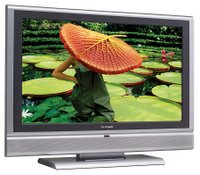Viewsonic N3260W - LCD TV
 Like Acer, Viewsonic is a name that people will associate with computer components rather than household entertainment devices. And, like the Acer AT3201W, the Viewsonic N3260W betrays its desktop roots in several ways.
Like Acer, Viewsonic is a name that people will associate with computer components rather than household entertainment devices. And, like the Acer AT3201W, the Viewsonic N3260W betrays its desktop roots in several ways.First, the menus and set-up system are unnecessarily awkward. Despite having an analogue-only tuner, the automated setup took a comparatively long time to complete. And when it had finished, we had to go through the whole thing all over again because all the tuner settings were lost when we tried to turn the volume down before accepting the new changes.
Second, the Viewsonic’s picture wasn’t especially impressive. In our tests the set’s colours were overly garish, and we had to take the saturation right down for most sources. Analogue TV looked worst of all, but even true 1080i and 720p HD video via the component inputs showed a marked increase in colour bleeding over the other screens in the test. There was also excessive noise in the picture, particularly with the DVD we played through the set’s HDMI and RGB Scart inputs.
The N3260W was one of the worst sets to be affected by motion blur. This was specifically evident on the DVD through the HDMI and RGB inputs. It was even noticeable in the true HD footage we tested, although to a much lesser degree. Curiously, the manufacturer quoted us a relatively fast response time of 8 milliseconds, which would normally help to reduce the motion blur effect.
Either way, the unholy triumvirate of saturation, noise and motion blur conspire to produce by far the worst picture of all the screens in this group. And even with a lot of fiddling in the annoying and inadequate settings menus, we couldn’t get particularly satisfactory results from broadcast TV or any of the set’s inputs.
At less than £900, the N3260W might be cheap but we suggest spending another £100 or so to get yourself a set with a much better picture.
[via: activehome]





